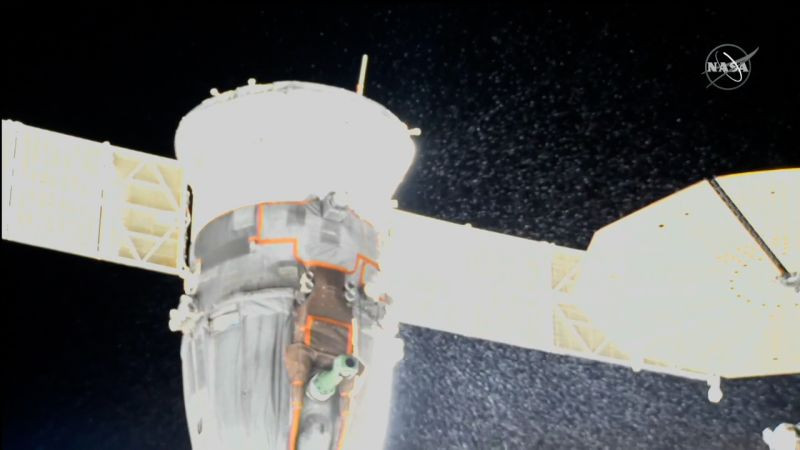Damaged Soyuz may leave crew with no way home
Though oddly beautiful in its own way, it's a sight no astronaut wants to see: their spacecraft, the only way for them to return to Earth, ejecting countless iridescent droplets of something thing in space.
When the crew of Apollo 13 saw their ship literally bleeding on its journey to the moon, it was clear that the mission, and ultimately their lives, were in danger. Fortunately, the current situation isn't as dire, as the leaky Soyuz MS-22 spacecraft docked with the International Space Station poses no immediate danger to those aboard the orbiting lab. But this is still an unprecedented situation, and to get his crew home, the engineers on the ground will have to make some very tough decisions.
This situation continues to develop, and neither NASA nor its Russian counterpart Roscosmos has released many details. But we can make educated guesses from the video and images we've seen of the damaged Soyuz capsule, and from what has been shown to the public so far, things don't look good.< /p> Runs empty
On Wednesday the 14th, as Russian cosmonauts Sergey Prokopyev and Dmitriy Petelin were preparing to begin a scheduled extravehicular activity (EVA) that would have taken them outside the Station, an alert went off indicating that levels of coolant in the docked Soyuz MS-22 capsule was falling. When panning the external cameras towards the spacecraft, it was immediately clear that this was not a false alarm - as liquid could be seen spewing from the rear of the vehicle.

As shown in the diagram above, the Soyuz pumps coolant through a pair of heat exchangers located in the orbital module (left) and the descent module (center), which heads eventually to several external heatsinks mounted on the outside of the Service Module (right). The coolant lines that connect these modules actually run along the exterior of the ship's hull, though they are hidden by the thermal blankets that cover most of the vehicle's exterior.
While the exact cause of the leak is not yet known, the current theory is that a micrometeoroid or other small space junk has hit the radiators or one of the external cooling ducts. The hope was that further examination over the weekend might help determine the cause of the leak, but either way the result is the same. With no way to stem the flow, it is believed that all of the coolant in the system was spilled overboard during the event, leaving the system inoperable.
The system is responsible for not only keeping the interior of the descent module at a comfortable temperature for its human occupants, but also for cooling flight computers and other equipment buried deep within the craft. Trying to repair and refill the cooling system in orbit would be exceptionally difficult, and will almost certainly be considered too risky to attempt. So the question Russian engineers must now answer is whether or not the Soyuz can safely bring its crew of three back to Earth with its cooling system offline.
Remote RescueAt the time of this writing, no official announcement has been made, but many space experts believe that the safest approach is to assume that the Soyuz MS-22 does not is no longer able to fly. While a system test conducted after the leak was discovered showed that the vehicle appeared to be operating normally and its thrusters were still functional, the pos...

Though oddly beautiful in its own way, it's a sight no astronaut wants to see: their spacecraft, the only way for them to return to Earth, ejecting countless iridescent droplets of something thing in space.
When the crew of Apollo 13 saw their ship literally bleeding on its journey to the moon, it was clear that the mission, and ultimately their lives, were in danger. Fortunately, the current situation isn't as dire, as the leaky Soyuz MS-22 spacecraft docked with the International Space Station poses no immediate danger to those aboard the orbiting lab. But this is still an unprecedented situation, and to get his crew home, the engineers on the ground will have to make some very tough decisions.
This situation continues to develop, and neither NASA nor its Russian counterpart Roscosmos has released many details. But we can make educated guesses from the video and images we've seen of the damaged Soyuz capsule, and from what has been shown to the public so far, things don't look good.< /p> Runs empty
On Wednesday the 14th, as Russian cosmonauts Sergey Prokopyev and Dmitriy Petelin were preparing to begin a scheduled extravehicular activity (EVA) that would have taken them outside the Station, an alert went off indicating that levels of coolant in the docked Soyuz MS-22 capsule was falling. When panning the external cameras towards the spacecraft, it was immediately clear that this was not a false alarm - as liquid could be seen spewing from the rear of the vehicle.

As shown in the diagram above, the Soyuz pumps coolant through a pair of heat exchangers located in the orbital module (left) and the descent module (center), which heads eventually to several external heatsinks mounted on the outside of the Service Module (right). The coolant lines that connect these modules actually run along the exterior of the ship's hull, though they are hidden by the thermal blankets that cover most of the vehicle's exterior.
While the exact cause of the leak is not yet known, the current theory is that a micrometeoroid or other small space junk has hit the radiators or one of the external cooling ducts. The hope was that further examination over the weekend might help determine the cause of the leak, but either way the result is the same. With no way to stem the flow, it is believed that all of the coolant in the system was spilled overboard during the event, leaving the system inoperable.
The system is responsible for not only keeping the interior of the descent module at a comfortable temperature for its human occupants, but also for cooling flight computers and other equipment buried deep within the craft. Trying to repair and refill the cooling system in orbit would be exceptionally difficult, and will almost certainly be considered too risky to attempt. So the question Russian engineers must now answer is whether or not the Soyuz can safely bring its crew of three back to Earth with its cooling system offline.
Remote RescueAt the time of this writing, no official announcement has been made, but many space experts believe that the safest approach is to assume that the Soyuz MS-22 does not is no longer able to fly. While a system test conducted after the leak was discovered showed that the vehicle appeared to be operating normally and its thrusters were still functional, the pos...
What's Your Reaction?






















